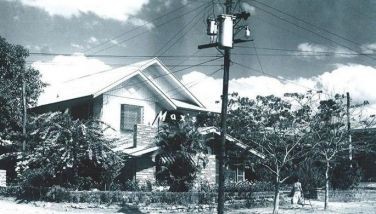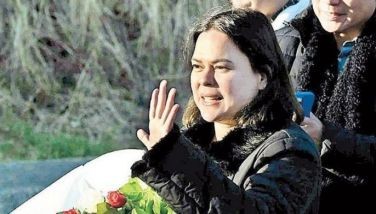Anniversary concerts
February 4, 2006 | 12:00am
The UST Conservatory of Music, headed by international concert pianist Raul Sunico as dean, presented "Tribute to Thomasians" at the CCP main theater to mark its 40th anniversary. The UST Symphony Orchestra under Conductor Rodel Colmenar played the frequently performed Symphony No. 9 in E Minor ("New World Symphony"). Haydn’s Trumpet Concerto in E Flat Major had Raymond de Leon as soloist; virtually the entire Mozart opera "Marriage of Figaro" (in Italian), minus the choral portions, featured guest, alumni and faculty soloists: soprano Rachelle Gerodias (Susanna), mezzo soprano Clarissa Ocampo (Cherubino), baritone Andrew Fernando (Count Almaviva), tenor Randy Gilongo (Basilio), bass Jun Francis Jarantilla (Bartolo), soprano Nenen Espina (Countess Almaviva), mezzo soprano Thea Perez (Marcellina) and baritone Noel Azcona (Figaro).
Under Colmenar’s baton, the orchestra conveyed massive sounds and diverse dynamics delineating the bustling excitement of the New World (New York) and the contrasting serenity of the countryside’s vast expanse. In the tightly structured composition, the themes kept recurring and interweaving, and except for two very brief off-tangent passages from a brass soloist, the interpretation eloquently hewed to the elements of style inherent in the piece.
In "The Marriage of Figaro", the singers exhibited varying degrees of fluency and expressivity. Particularly impressive were Gerodias and Ocampo. Gerodias manipulated her voice with superb control as she increased or decreased its volume, while infusing her rendition with sensitive artistry, intensity and passion. Ocampo sang with brio and aplomb in a voice that had grown considerably more forceful since I last heard her.
Of the male singers, Fernando, Azcona and Jarantilla highly impressed.
The Overture to "Figaro" clearly reflected the opera’s bubbly merriment and delightful agitation.
Raymond de Leon proved to be a singularly talented trumpet soloist demonstrating in the Haydn Concerto remarkable finger dexterity and agility, breath control, widely ranging dynamics and tonal hues within the limitations of his instrument. His impact was tremendous.
St. Paul University Manila College of Music and the Performing Arts, headed by Sr. Anunciata as dean, held "Baliktugtugan III" at the Fleur de Lis Auditorium to celebrate 65 years of music-making.
Its history looks back to distinguished professors Julio Esteban Anguita, Victoria Lobregat, Rosario Lopez Garcia, Antonio Molina, Stella G. Brimo, Jose Mossessgeld, Mercedes Matias Santiago, Elsa Aenlle, Ramon Corpus, Carmencita Arambulo, Ernestina Crisologo, Liwanag Cruz, et al.
Sr. Marie Vincent Llamzon pioneered in organizing a glee club and a string orchestra; the former performed jointly with the glee clubs of Harvard U. (1961) and Cornell U. (1966). Also in the 60s, Broadway musicals directed by Fr. James Reuter earned for the auditorium the sobriquet "Broadway on Herran St.". Oscar Yatco served as musical director in major choral works.
The inclusion of too many alumnae, alumni, faculty, students and guests made the program overlong. To my mind, certain numbers were dispensable.
The opening remarks of President Wynna Marie Medina were followed by Ariel Arambulo’s absorbing "Immaculate Mother Variations" for which Arambulo was first violinist and conductor. Margarita Reyes and Kimberly Tan were on second violins; Jasmine Corrina Balbutin and John Jerry Ginon, on violas; Michael Buenaventura and Herrick Ortiz, on cellos; Chloe Canton was pianist. As the piece was ending, Arambulo’s very young violin students lent their endearing presence by joining the remarkable performance of a remarkable work.
Thea Perez, soprano, Ronan Ferrer, tenor, and Najib Ismail, pianist, interpreted a Puccini duet from La Boheme. The strings took the limelight again: Guitar maestro Jose Valdez and Victor Abella played Fernando Sor’s "Sonata Encouragement"; Alcrisara Ramintas, Maybelle Aboyabor, Rocky Reambonanza were led by Valdez in Lecuona’s Andalucia and the traditional El Vito.
Poulenc’s Piano Sonata, lending an avant-garde touch, was interpreted with verve and vibrancy by Mary Anne Espina and Najib Ismail. Tenor Ramon Acoymo, UP College of Music dean, stood out not only for his colorful outfit but also for his forceful voice and clear diction in "Songs of Love" with lyrics by him and music by F. Obispo. Pianist Harold Galang, PWU College of Music dean, assisted.
One would have to listen again to Priscilla Halili Enriquez’s striking Contrapunctum for a fuller evaluation. Pianists were Ma. Luisa Fucoy-Montero, primo; Elizabeth Flordeliza, secondo; composer Enriquez, primo; Teresita Comia-David, secondo.
Original paintings by Enriquez were on display at the lobby.
German-based Imelda Asiaten and Julie Ann Hallazgo infused Manuel Infante’s piano work Sentimiento with considerable zest and spirit. Soprano Irma P.E. Potenciano made up for her thin volume with impeccable technique and intense feeling in an Adriana Lecouvreur aria and in E. Cuenco’s Bawat Sandali. Jonathan Coo was assisting artist.
The marvelous marimba soloist Dena Fernandez masterfully produced diverse tonal colors and controlled dynamics in E. Soto’s The Spinner and Sibelius’ Romance. Dena, with pianist Mary Anne Espina admirably collaborating, provided one of the concert highlights.
Another was Schumann’s Piano Trio as superbly played by violinist Oscar Yatco, cellist Renato Lucas and pianist Asiaten. The interplay between the strings glowed and shimmered; the piano offered exquisite tonal contrast.
Still another highlight was Strauss’ waltzes as freely adapted for two pianos by Abram Chasins, and as powerfully rendered by Raul Sunico and Carmencita Castro Bautista.
Theater stalwart Tommy Abuel was narrator for Tom Scott’s The Creation; Sr. Teresita Estrellita Orlina was soloist in Santiago’s Sa Libis ng Nayon; Ernest Gold’s The Exodus Song had Sr. Anunciata conducting the SPC Manila Chorale and pianist Asiaten. Handel’s Hallelujah, expressly orchestrated by Alfredo Buenaventura for the concert and sung by the Chorale, the Alumnae and Ateneo Alumni Glee Clubs, the Diamond Jubilee Concert Performers and Instrumental Ensemble, with Asiaten as pianist, was formidably conducted by Oscar Yatco. Earlier, the orchestra pit was deservedly named in his honor.
Under Colmenar’s baton, the orchestra conveyed massive sounds and diverse dynamics delineating the bustling excitement of the New World (New York) and the contrasting serenity of the countryside’s vast expanse. In the tightly structured composition, the themes kept recurring and interweaving, and except for two very brief off-tangent passages from a brass soloist, the interpretation eloquently hewed to the elements of style inherent in the piece.
In "The Marriage of Figaro", the singers exhibited varying degrees of fluency and expressivity. Particularly impressive were Gerodias and Ocampo. Gerodias manipulated her voice with superb control as she increased or decreased its volume, while infusing her rendition with sensitive artistry, intensity and passion. Ocampo sang with brio and aplomb in a voice that had grown considerably more forceful since I last heard her.
Of the male singers, Fernando, Azcona and Jarantilla highly impressed.
The Overture to "Figaro" clearly reflected the opera’s bubbly merriment and delightful agitation.
Raymond de Leon proved to be a singularly talented trumpet soloist demonstrating in the Haydn Concerto remarkable finger dexterity and agility, breath control, widely ranging dynamics and tonal hues within the limitations of his instrument. His impact was tremendous.
Its history looks back to distinguished professors Julio Esteban Anguita, Victoria Lobregat, Rosario Lopez Garcia, Antonio Molina, Stella G. Brimo, Jose Mossessgeld, Mercedes Matias Santiago, Elsa Aenlle, Ramon Corpus, Carmencita Arambulo, Ernestina Crisologo, Liwanag Cruz, et al.
Sr. Marie Vincent Llamzon pioneered in organizing a glee club and a string orchestra; the former performed jointly with the glee clubs of Harvard U. (1961) and Cornell U. (1966). Also in the 60s, Broadway musicals directed by Fr. James Reuter earned for the auditorium the sobriquet "Broadway on Herran St.". Oscar Yatco served as musical director in major choral works.
The inclusion of too many alumnae, alumni, faculty, students and guests made the program overlong. To my mind, certain numbers were dispensable.
The opening remarks of President Wynna Marie Medina were followed by Ariel Arambulo’s absorbing "Immaculate Mother Variations" for which Arambulo was first violinist and conductor. Margarita Reyes and Kimberly Tan were on second violins; Jasmine Corrina Balbutin and John Jerry Ginon, on violas; Michael Buenaventura and Herrick Ortiz, on cellos; Chloe Canton was pianist. As the piece was ending, Arambulo’s very young violin students lent their endearing presence by joining the remarkable performance of a remarkable work.
Thea Perez, soprano, Ronan Ferrer, tenor, and Najib Ismail, pianist, interpreted a Puccini duet from La Boheme. The strings took the limelight again: Guitar maestro Jose Valdez and Victor Abella played Fernando Sor’s "Sonata Encouragement"; Alcrisara Ramintas, Maybelle Aboyabor, Rocky Reambonanza were led by Valdez in Lecuona’s Andalucia and the traditional El Vito.
Poulenc’s Piano Sonata, lending an avant-garde touch, was interpreted with verve and vibrancy by Mary Anne Espina and Najib Ismail. Tenor Ramon Acoymo, UP College of Music dean, stood out not only for his colorful outfit but also for his forceful voice and clear diction in "Songs of Love" with lyrics by him and music by F. Obispo. Pianist Harold Galang, PWU College of Music dean, assisted.
One would have to listen again to Priscilla Halili Enriquez’s striking Contrapunctum for a fuller evaluation. Pianists were Ma. Luisa Fucoy-Montero, primo; Elizabeth Flordeliza, secondo; composer Enriquez, primo; Teresita Comia-David, secondo.
Original paintings by Enriquez were on display at the lobby.
German-based Imelda Asiaten and Julie Ann Hallazgo infused Manuel Infante’s piano work Sentimiento with considerable zest and spirit. Soprano Irma P.E. Potenciano made up for her thin volume with impeccable technique and intense feeling in an Adriana Lecouvreur aria and in E. Cuenco’s Bawat Sandali. Jonathan Coo was assisting artist.
The marvelous marimba soloist Dena Fernandez masterfully produced diverse tonal colors and controlled dynamics in E. Soto’s The Spinner and Sibelius’ Romance. Dena, with pianist Mary Anne Espina admirably collaborating, provided one of the concert highlights.
Another was Schumann’s Piano Trio as superbly played by violinist Oscar Yatco, cellist Renato Lucas and pianist Asiaten. The interplay between the strings glowed and shimmered; the piano offered exquisite tonal contrast.
Still another highlight was Strauss’ waltzes as freely adapted for two pianos by Abram Chasins, and as powerfully rendered by Raul Sunico and Carmencita Castro Bautista.
Theater stalwart Tommy Abuel was narrator for Tom Scott’s The Creation; Sr. Teresita Estrellita Orlina was soloist in Santiago’s Sa Libis ng Nayon; Ernest Gold’s The Exodus Song had Sr. Anunciata conducting the SPC Manila Chorale and pianist Asiaten. Handel’s Hallelujah, expressly orchestrated by Alfredo Buenaventura for the concert and sung by the Chorale, the Alumnae and Ateneo Alumni Glee Clubs, the Diamond Jubilee Concert Performers and Instrumental Ensemble, with Asiaten as pianist, was formidably conducted by Oscar Yatco. Earlier, the orchestra pit was deservedly named in his honor.
BrandSpace Articles
<
>
- Latest
- Trending
Trending
Latest




























